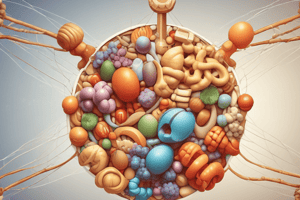Podcast
Questions and Answers
What is the general formula for carbohydrates as represented in the content?
What is the general formula for carbohydrates as represented in the content?
- C6H12O6
- C5H10O5
- CnH2nOn (correct)
- CnH2nO
Which of the following statements accurately describes monosaccharides?
Which of the following statements accurately describes monosaccharides?
- They are single sugar units. (correct)
- They can have up to 10 sugar units.
- They consist of 2 sugar units.
- They are also known as polysaccharides.
What type of carbohydrate is defined by having more than one -OH group?
What type of carbohydrate is defined by having more than one -OH group?
- Monosaccharide (correct)
- Disaccharide
- Oligosaccharide
- Polysaccharide
Which carbohydrate structure has the highest number of sugar units?
Which carbohydrate structure has the highest number of sugar units?
In the process of respiration, what energy reactants are utilized by carbohydrates?
In the process of respiration, what energy reactants are utilized by carbohydrates?
Which of these carbohydrates is essential for forming the backbone of nucleic acids?
Which of these carbohydrates is essential for forming the backbone of nucleic acids?
Which structural form can carbohydrates adopt?
Which structural form can carbohydrates adopt?
Ketoses are distinguished from aldoses primarily by what characteristic?
Ketoses are distinguished from aldoses primarily by what characteristic?
What distinguishes homodisaccharides from heterodisaccharides?
What distinguishes homodisaccharides from heterodisaccharides?
Which of the following is a feature of monosaccharides?
Which of the following is a feature of monosaccharides?
Which carbohydrate serves as the major storage polysaccharide in animals?
Which carbohydrate serves as the major storage polysaccharide in animals?
What is the main difference between aldohexose and ketohexose?
What is the main difference between aldohexose and ketohexose?
Which of the following indicates a K ketose sugar?
Which of the following indicates a K ketose sugar?
What defines a heteropolysaccharide?
What defines a heteropolysaccharide?
What is the chemical composition of lactose?
What is the chemical composition of lactose?
Which carbohydrate is primarily associated with infant feeding?
Which carbohydrate is primarily associated with infant feeding?
How are polysaccharides categorized?
How are polysaccharides categorized?
What does the suffix 'ose' typically indicate in carbohydrate nomenclature?
What does the suffix 'ose' typically indicate in carbohydrate nomenclature?
Flashcards
Carbohydrates
Carbohydrates
Organic compounds with the general formula (CH₂O)ₙ. They are the primary source of energy for the body.
Monosaccharides
Monosaccharides
Simple sugars; single sugar units, like glucose or fructose.
Disaccharides
Disaccharides
Two monosaccharides linked together.
Polysaccharides
Polysaccharides
Signup and view all the flashcards
General formula of carbohydrates
General formula of carbohydrates
Signup and view all the flashcards
Monosaccharide types
Monosaccharide types
Signup and view all the flashcards
Carbohydrate function - energy source
Carbohydrate function - energy source
Signup and view all the flashcards
Carbohydrate function - Nucleic acids
Carbohydrate function - Nucleic acids
Signup and view all the flashcards
Maltose
Maltose
Signup and view all the flashcards
Sucrose
Sucrose
Signup and view all the flashcards
Lactose
Lactose
Signup and view all the flashcards
Starch
Starch
Signup and view all the flashcards
Cellulose
Cellulose
Signup and view all the flashcards
Glycogen
Glycogen
Signup and view all the flashcards
Monosaccharide Structure
Monosaccharide Structure
Signup and view all the flashcards
Study Notes
Biochemistry Overview
- Biochemistry studies the chemical processes within and relating to living organisms
- Key components include carbohydrates, lipids, proteins, vitamins, minerals, enzymes, endocrine glands and hormones, and human metabolism
Carbohydrates
- Composed of carbon, hydrogen, and oxygen (C:H:O ratio of 1:2:1)
- Function as a primary energy source
- Classified based on the number of sugar units:
- Monosaccharides (1 sugar unit): Simplest form, e.g., glucose, fructose, galactose
- Disaccharides (2 sugar units): Formed by joining two monosaccharides, e.g., sucrose, maltose, lactose
- Oligosaccharides (3-10 sugar units): Short chains of monosaccharides
- Polysaccharides (>10 sugar units): Large chains of monosaccharides, e.g., starch, cellulose, glycogen, dextrin, dextran
- General formula for carbohydrates: CnH2nOn
- General formula for glucose with 6 carbon atoms: C6H12O6
- Carbohydrates are polyhydroxy aldehydes or ketones (have more than one -OH group)
- Can exist in a long-chain or ring structure
- Important components of nucleic acids (DNA, RNA)
- Make up a significant portion of plant dry weight (~¼)
- Main source of energy for the body: Glucose + O2 → CO2 + H2O + Energy
- Monosaccharides are the simplest form of carbohydrates and cannot be broken down further
- Nomenclature: Function group and number of carbon atoms (e.g., aldohexose, ketohexose)
Disaccharides
- Formed by joining two monosaccharides through dehydration synthesis
- Types include:
- Maltose (glucose + glucose)
- Sucrose (glucose + fructose)
- Lactose (glucose + galactose)
Polysaccharides
- Important energy storage molecules (starch and glycogen) or structural components (cellulose)
- Homopolysaccharides contain one type of sugar unit (e.g., starch, cellulose, glycogen, dextrin, dextran)
- Heteropolysaccharides contain more than one type of sugar unit (e.g., heparin)
Studying That Suits You
Use AI to generate personalized quizzes and flashcards to suit your learning preferences.
Related Documents
Description
Explore the fundamentals of biochemistry, focusing on the chemical processes that sustain life. This quiz delves into key components like carbohydrates, their classifications, and functions within the human metabolism. Assess your understanding of biochemistry concepts and carbohydrate structures through engaging questions.




